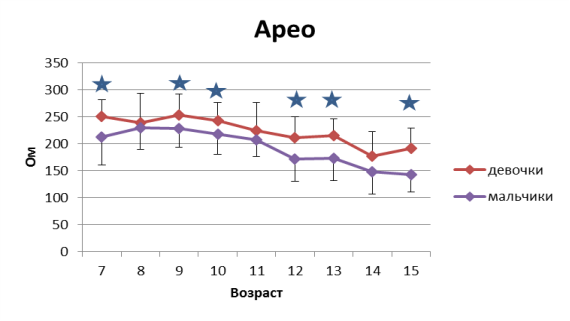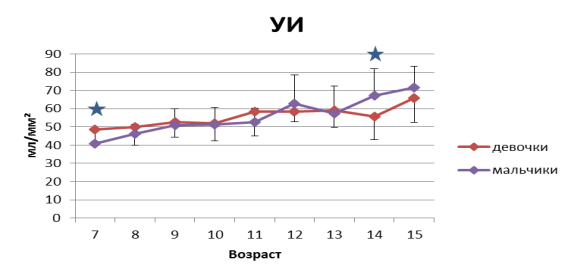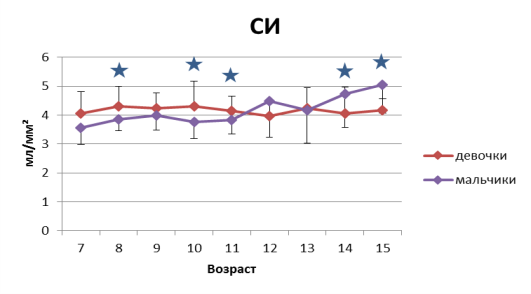Introduction. In each age period, cardiovascular system (CVS) undergoes certain changes depending on physiological needs. Especially these changes can be observed during the period of the growth of the organism. Taking into account the peculiarities of cardiovascular system development seems to be more important in case of early sport specialisation which can be observed in different kinds of sport. Those children who start to play hockey at the age of 10–11 show adaptive changes in the work of CVS due to the amount of training loads [2, 3].
Methods and organization of the research. The children aged 7–15 were under analysis for the purpose of defining the peculiarities of cardiovascular system development and characteristic changes which can be observed as well as the degree of dependence of these indicators and the age (Table 1).
Table 1
Age distribution
|
Age (years) |
7 |
8 |
9 |
10 |
11 |
12 |
13 |
14 |
15 | |
|
Amount |
Girls |
9 |
9 |
20 |
21 |
19 |
6 |
19 |
17 |
5 |
|
Boys |
17 |
37 |
64 |
46 |
38 |
31 |
22 |
28 |
26 | |
The record of cardio hemodynamic data was organized in lying position with the help of the monitoring system MARG 10–01 (Microlux, Chelyabinsk).
The following indicators were registered: APPG (photoplethysmogram ripple amplitude), AAP (amplitude of aortic pulsation), SI (stroke index), CI (cardio index), TPRI (total peripheral resistance index), MPA (microvascular pulsation amplitude).
The statistic analysis was made with the help of SPSS 20 program.
Results.
Vascular components of blood circulation. The analysis shows that the dynamics of cardiovascular system indicators has gender peculiarities both in pre-pubertal and pubertal periods. A great number of essential indicators was observed in amplitude of aortic pulsation which had better expressed among girls (Fig.1). This phenomenon was mentioned earlier in some works by the researchers who had been observing similar differences but in mixed group of boys and girls [1]. This can be probably defined by the peculiarities of elastic properties of the aorta which has a strong gender conditionality. At the same time the indicator of peripheral blood flow — microvascular pulsation amplitude — did not show any change.
![]()

![]()
![]()
![]()

Fig. 1. The indicators of aorta pulsation amplitude
* — statistic importance at p<0.05
The tendency of lower indicators among girls was noticed.
Peripheral resistance index — the normal indicator of vascular resistance of the body area, also had essential differences between the groups under study. The highest indicators were recorded among boys under 12, though within the pubertal period the opposite situation was observed — highest indicators among girls (Fig.2).

![]()
![]()

Fig. 2. The indicators of total peripheral resistance index.
* — statistic importance at p<0.05
![]() Volumetric characteristics of blood circulation. The indicators of stroke minute volume of blood circulation are not objective because of their dependence on weight and height parameters of those under research. The authors of this paper used stroke and cardio indices — normal indicators due to the body area.
Volumetric characteristics of blood circulation. The indicators of stroke minute volume of blood circulation are not objective because of their dependence on weight and height parameters of those under research. The authors of this paper used stroke and cardio indices — normal indicators due to the body area.
The statistically important differences in indicators of SI were noticed in the group aged 7 (higher indicators among girls) and the group aged 15 (higher indicators among boys). In most cases the indicators were similar.
![]()

![]()

Fig. 3. The indicators of stroke index
* — statistic importance at p<0.05
Another situation was recorded in the indicators of cardio index where gender differences were expressed more intensively (Fig.3). So, in pre-pubertal period the highest results of CI were shown among girls, in pubertal — among boys. The same situation is noted in parameter SI, but mostly on the level of tendency.
![]()

![]()
![]()

Fig. 4. The indicators of cardio index.
* — statistic importance at p<0.05
Conclusion.
The research shows that gender differences between girls and boys in the indicators of blood circulation exist both in pubertal and pre-pubertal periods. Some indicators have a turning point at the age of 13. After this age, an essential characteristic change of hemodynamic parameters due to gender peculiarities (cardio and stroke index, total peripheral resistance index) are observed.
References:
- Demidov V. A., Mavliev F. A., Khasnutdinov N.Sh. The variability in the complex of hemodynamic parameters of young men and women doing and not doing sport // Human Physiology. — 2009. — V. 35. — №. 1. — P. 84.
- Mavliev F. A., Zotova F. R., Samsykin A. S. The peculiarities of cardio hemodynamics of young hockey players aged 10–11 // Scientific Notes of the University named after P. F. Lesgaft. — 2012. — №. 11 (93).
- Mavliev F. A., Zotova F. R., Nazarenko A. S. The dynamics of cardio hemodynamic indicators of hockey players during preparatory period // Vestnik of sports science. 2015. V. 2. P. 31–35.

